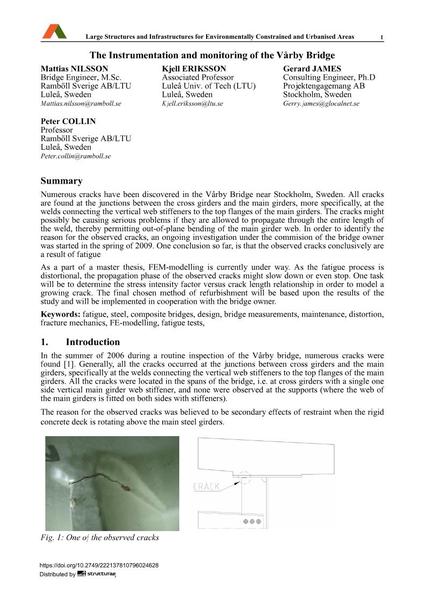The Instrumentation and monitoring of the Vårby Bridge

|
|
|||||||||||
Détails bibliographiques
| Auteur(s): |
Mattias Nilsson
Kjell Eriksson Gerard James Peter Collin |
||||
|---|---|---|---|---|---|
| Médium: | papier de conférence | ||||
| Langue(s): | anglais | ||||
| Conférence: | IABSE Symposium: Large Structures and Infrastructures for Environmentally Constrained and Urbanised Areas, Venice, Italy, 22-24 September 2010 | ||||
| Publié dans: | IABSE Symposium Venice 2010 | ||||
|
|||||
| Page(s): | 300-301 | ||||
| Nombre total de pages (du PDF): | 8 | ||||
| Année: | 2010 | ||||
| DOI: | 10.2749/222137810796024628 | ||||
| Abstrait: |
Numerous cracks have been discovered in the Vårby Bridge near Stockholm, Sweden. All cracks are found at the junctions between the cross girders and the main girders, more specifically, at the welds connecting the vertical web stiffeners to the top flanges of the main girders. The cracks might possibly be causing serious problems if they are allowed to propagate through the entire length of the weld, thereby permitting out-of-plane bending of the main girder web. In order to identify the reason for the observed cracks, an ongoing investigation under the commision of the bridge owner was started in the spring of 2009. One conclusion so far, is that the observed cracks conclusively are a result of fatigue As a part of a master thesis, FEM-modelling is currently under way. As the fatigue process is distortional, the propagation phase of the observed cracks might slow down or even stop. One task will be to determine the stress intensity factor versus crack length relationship in order to model a growing crack. The final chosen method of refurbishment will be based upon the results of the study and will be implemented in cooperation with the bridge owner. |
||||
| Mots-clé: |
acier design ponts mixtes
|
||||
